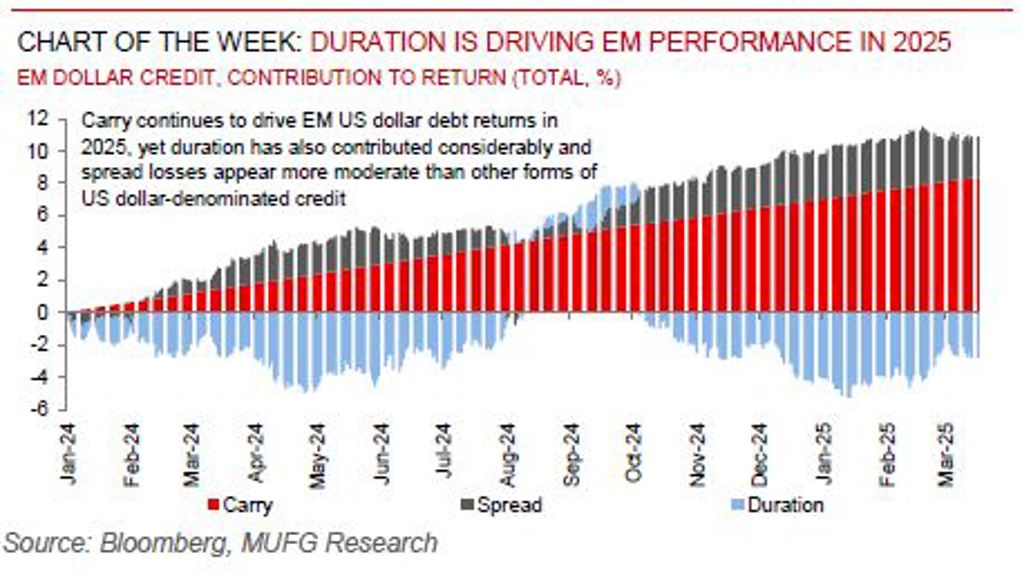Emerging markets brace for a volatile second quarter ahead
EHSAN KHOMAN
Head of Commodities, ESG and
Emerging Markets Research –
EMEA
DIFC Branch – Dubai
T:+971 (4)387 5033
E: ehsan.khoman@ae.mufg.jp
SOOJIN KIM
Research Analyst
DIFC Branch – Dubai
T: +44(4)387 5031
E: soojin.kim@ae.mufg.jp
LEE HARDMAN
Senior Currency Analyst
Global Markets Research
Global Markets Division for EMEA
T: +44(0)20 577 1968
E: lee.hardman@uk.mufg.jp
MUFG Bank, Ltd.
A member of MUFG, a global financial group
Macro focus
What a quarter this has been. Granted, few expected it to be a quiet period, given the highly unpredictable global backdrop – ranging from looming tariffs under the new US administration and uncertainty about the rebound in the Chinese economy to shifting inflation and monetary policy expectations and rising fiscal concerns – but the scale and scope of shifts in market narratives has been surprising. These shifts have triggered a volatile ride in global markets, though, EMs have managed to navigate the ebbs and flows admirably, with all major assets – credit, rates, debt, FX and equities – up year-to-date. Yet, we are cautious heading in the second quarter and view trade-fuelled economic headwinds will intensify, due to payback effects from export front-loading and potential tariff setbacks from 2 April (date when the US administration unveils its plan for reciprocal tariffs) onwards. This would likely impact the CEE region, parts of EM Asia and Mexico (and beyond), as well as reinforce the recent dovish central bank bias. We also believe that prudence is necessary on deciding which trade-insulated EM jurisdiction to hide in, as idiosyncratic risks have surfaced in Colombia, Indonesia, South Africa and Turkey.
FX views
EM FX have weakened modestly against the USD over the past week after the dovish Fed’s policy update pulled down US yields and President Trump’s tariffs seemingly will be more targeted. The TRY has been the worst performing currency over the past week triggered by the latest domestic political developments in Turkey. USD/TRY initially jumped above the 41.000-level but has since dropped back below the 38.000-level. It marks a step up in the pace of TRY depreciation which had been declining by an annualized rate of around -15% against the USD. The main trigger for the faster TRY sell-off has been the detention and formal arrest of Istanbul Mayor, Ekrem Imamoglu, who was jailed on corruption charges on Sunday..
Week in review
Following reports on 19 March that the Turkish authorities had arrested Istanbul Mayor, Ekrem Imamoglu, alongside several others, the USD/TRY moved acutely higher, trading over 10%. This move was broadly reversed as the Central Bank of Turkey (CBRT) and Turkish state banks sold ~USD12bn US dollars with spot closing ~3% higher. In an unscheduled meeting on 21 March, the CBRT raised the overnight (ON) lending rate from 44% to 46%, though kept its policy rate (one-week repo rate) and the overnight borrowing rate unchanged at 42.5% and 41%, respectively. In a separate decision, the CBRT also announced it would resume lira-settled FX forward selling transactions (last used in early 2024), and that it would suspend one-week repo auctions to tighten lira liquidity. Beyond Turkey, the South African Reserve Bank (SARB) kept its policy rate at 7.50%, in line with our (and consensus) expectations, citing heightened sources of uncertainty. The Central Bank of Russia (CBR) maintained its key rate at 21.00% in line with our (and consensus) expectations, with a more dovish tilt. Inflation in Saudi Arabia remained stable at 2.0% y/y in February, in line with our (and consensus) forecasts. Finally, the IMF and Kenyan authorities have decided not to proceed with the ninth review of the current Extended Fund Facility / Extended Credit Facility programme.
Week ahead
This week, there will be rates meetings in Hungary (MUFG and consensus: on hold at 6.50%) and the Czech Republic (MUFG and consensus: on hold at 3.75%).
Forecasts at a glance
The external backdrop for EM has shifted abruptly – the soft-landing pro-risk environment and pricing of non-recessionary Fed cuts has given way to concerns around tariff risks (and likely retaliatory action), higher-for-longer US rates and a strong US dollar. This sets the stage for a challenging EM backdrop in 2025. There are dimensions that could make Trump 2.0 less disruptive. Given the reduced direct trade exposure of the Chinese economy to the US and expectations that there will be a monetary and fiscal response by Chinese policymakers to offset the tariff growth shock, the economic and financial market disruptions will, on aggregate, be less severe than Trump 1.0.
Core indicators
The latest weekly IIF flow data signalled that EM securities witnessed outflows of USD10.0bn in the week ending 21 March, predominantly led by equities (USD-9.5bn) relative to debt (USD-0.5bn).


